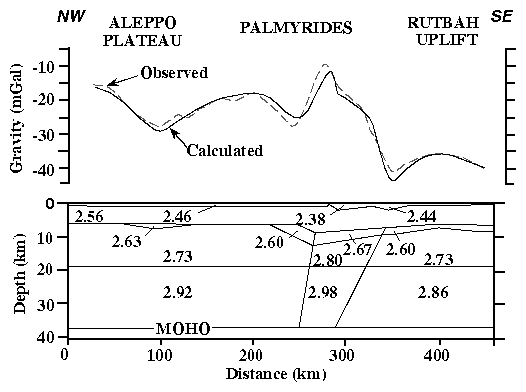
Home
| Results Summary | Publications
| Participants | M.East / N.Africa Home

Best, J. A., Barazangi, M., Al-Saad, D., Sawaf, T., and Gebran, A.
Bouguer gravity trends and crustal structure of the Palmyride mountain belt and surrounding northern Arabian platform in Syria
Geology, 18, 1235-1239, 1990.
Abstract
This study examines the crustal structure of the Palmyrides and
the northern Arabian platform in Syria by two- and three-dimensional modeling
of the Bouguer gravity anomalies. Results of the gravity modeling indicate
that: (1) western Syria is composed of at least two different crustal blocks,
(2) the southern crustal block is penetrated by a series of crustal-scale,
high-density intrusive complexes, and (3) short-wavelength gravity anomalies
in the southwest part of the mountain belt are clearly related to basement
structure. The crustal thickness in Syria, as modeled on the gravity profiles,
is approximately 40 +/- 4 km, which is similar to crustal thicknesses
interpreted from refraction data in Jordan and Saudi Arabia. The different
crustal blocks and large-scale mafic intrusions are best explained, though not
uniquely, by Proterozoic convergence and suturing and early Paleozoic rifting,
as interpreted in the exposed rocks of the Arabian shield. These two processes,
combined with documented Mesozoic rifting and Cenozoic transpression, comprise
the crustal evolution of the northern Arabian platform beneath Syria.
Key Figures and Captions
Figure 1. Observed and calculated gravity for profile II, showing preferred
crustal model. Regional positive gravity gradient from south to north is
modeled in this case by change in density of lower crust from 2.86
g/cm3 in south to 2.92 g/cm3 in north.

Go back to Summary of Results
Go back to Cornell Syria Project Welcome Page
![]()
